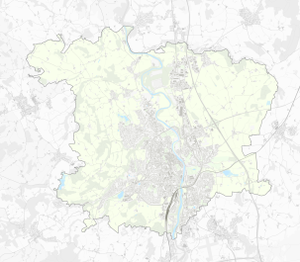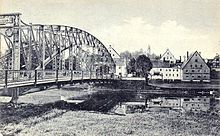St. Mang Bridge
Coordinates: 47 ° 43 ′ 30 ″ N , 10 ° 19 ′ 22 ″ E
| St. Mang Bridge | ||
|---|---|---|
| View over the St. Mang Bridge to the West (2015) | ||
| use | Individual traffic , Bundesstrasse 19 | |
| Crossing of | Iller | |
| place |
Kempten (Allgäu) , Germany |
|
| Building number | 8227 508 | |
| construction | Composite steel bridge | |
| overall length | 53.6 m | |
| width | 15 m | |
| Clear width | 51.8 m | |
| Construction height | 1.22 m | |
| Clear height | 2.8 m | |
| building-costs | 430,000 DM | |
| start of building | March 15, 1951 | |
| completion | November 15, 1952 | |
| location | ||
|
|
||
| Above sea level | 665.44 m | |
The St. Mang Bridge is a bridge for private traffic that crosses the Iller in the old town of Kempten (Allgäu) . Today's bridge has various historical precursors.
history
Forerunner of today's bridge
Bridges at this point have been handed down from at least the 14th century. What is certain is that in 1340 the citizens were able to dispose of the medieval bridge and thus also collected the bridge toll . The bridge was owned by the prince monastery of Kempten , which gave the building to the imperial city of Kempten as a fief . The imperial city had the obligation to maintain the bridge and to rebuild it after it had been destroyed.
The different wooden bridges represented an important long-distance route: they enabled trade relations with Kaufbeuren, Augsburg and Füssen, and also ensured constant income for the imperial city of Kempten. A flood of the Iller, as happens more often in mountain rivers, was an economic threat to the imperial city. The flood took the structure supported by wooden pillars with it.
In 1893, the five-year old wooden Iller Bridge was replaced by a column-free steel structure with an upper supporting structure. The St. Mang Bridge was particularly important after the Second World War . At the end of the war, the German Wehrmacht gave the order to blow up all bridges when the Allies approached. The eastern parts of the König-Ludwig-Brücke , which was used for private traffic, and the Upper Illerbrücken , for rail traffic, were blown up. The same order was given for the St. Mang Bridge, but citizens were able to prevent the demolition. After the Second World War, the St. Mang Bridge was the only navigable bridge in Kempten for a short time.
Bridge since 1952
In 1952, it was replaced by a cantilever bridge, and Prime Minister Wilhelm Hoegner was present at the opening in addition to Mayor August Fischer . The construction was carried out by the now dissolved construction company Alfred Kunz . The bridge was necessary because the old steel structure was no longer sufficient for the growing traffic and, in particular, was too narrow to guide road traffic with one lane in each direction.
On the right bank of the St. Mang Bridge, the sculptures of Saints Magnus and Lorenz sit on a pedestal . This work was designed by the entrepreneur and sculptor Karl Hoefelmayr (1907–1989).
In 2016 it became known that parts of the bridge were damaged or needed to be repaired. The bridge has to be closed for a long time, which would cause traffic chaos in the city. Furthermore, this would only be a temporary solution, as the bridge would have to be renewed after a certain period of time.
Individual evidence
- ^ Kempten, Imperial City. In: historisches-lexikon-bayerns.de (accessed on December 18, 2013)
- ↑ Volker Dotter Weich, Karl Filser et al. (Ed.): History of the city of Kempten. Dannheimer, Kempten 1989, ISBN 3-88881-011-6 , p. 447.
- ↑ Volker Dotter Weich, Karl Filser et al. (Ed.): History of the city of Kempten. Dannheimer, Kempten 1989, ISBN 3-88881-011-6 , plate 60.2.
- ^ Bernard Kühling: Allgäuer Künstlerlexikon. Kempten 2012, p. 155.
- ^ City of Kempten (ed.): Kempten im Allgäu. (3rd documentation), Kösel, Kempten 1972, p. 123.




